Abstract
The value of education is dependent on the degree in which school answers real life requests for both, the quality of human resource and “human capital” as a product – the two essentially conditioned by being anchored to this reality. This paper aims at studying and presenting the main socio-demographic characteristics of student population and also the analysis of family structure and socio-demographic characteristics of students’ parents. We investigated the relation of the characteristics of student profiles with their technological or vocational choices and majors. Our study intends to underline the possible differences of student communities according to their choice of education. The research was focused on the descriptive analysis of the characteristics of students enrolled in vocational and technological schools in Bihor County and on investigating the relation between the majors in vocational and technological educational systems chosen by the students in Bihor and their socio-demographic characteristics. Research data was collected through a questionnaire based interview conducted on a subject lot of 2028 students from vocational and technological high schools in the western part of Romania, in Bihor County.
Keywords: Vocational educational systemtechnological educational systemhuman capital
Introduction
One dimension of education is that of an actionary nature that is presented and manifested itself in what the individual does, especially in the process of realizing the material goods, as the basis of the existence of society. According to Ciobanu (2018) education is defined as a multi-level complex process whose success depends on a multitude of rigorously elaborated factors (material, spiritual, organizational).The profession represents the main framework in which the educational dimension of the education is materialized, its results depending on the vocation, considered one of the dominance of the human personality. Referring to this interaction between profession and vocation, Romanian pedagogue C. Narly (1938) shows that "the profession as a social requirement corresponds in the individual to the vocation, the form of manifestation of the specific originality of the individual" (p. 230).
Over time, the concept of Vocational and Technological Education has known a number of names in Romanian territory, closely related to the specifics of the time, but its mission was the same, namely to prepare skilled labor for the various economic sectors. Currently, the tasks of this kind of education are different compared to the previous periods, consisting in: "the formation of the cultural - professional horizon; the development of capacities, competences and practical skills for practicing the profession and familiarizing students with different professions and raising their interest in them" (Ciucă, 2006, p. 10).
The aim of the vocational and technological training system is therefore to respond as closely as possible to the educational needs, individual skills and aspirations and labor market demand. Admission to the education system and engagement of people with intellectual abilities and aspirations is often limited, and some decisions on qualifications and the number of students trained in a particular qualification are not based on individual assessment and market research. In the case of these types of schools, didactic activity in the school pursues and ensures, compared to the theoretical or real-humanist ones, a general culture training simultaneously with the acquisition of professional competence, representing a set of tasks, tasks which implies a place of job (Vlădulescu, 1997; Florescu, & Barth, 2017).
The higher the level of competences to perform a job, the more numerous and diversified the types of competences to be acquired in the professional training process, and the quality of the content of the training provided by the study objects must be synchronized with the development needs of the students' personality and social, economic and cultural needs.
Problem Statement
As a subject of analysis of this paper, Romanian Vocational and Technological Education is a very vast field, which can be surprised by a complex approach. That is why in the present paper we have only surprised some more conclusive, to the extent of the available data, to identify some profiles, features and competencies of the enrolled students who may have some influence on the vocational and technological school in Romania in the 21st century. Thus, we propose to present the main socio-demographic characteristics describing the pupil population and the analysis of the family structure and the socio-demographic characteristics of the students' parents.
In the sociological survey we investigated the relationship these characteristics have in describing the profiles of the students, with the profiles and specializations to which they are enrolled in the vocational and technological education. The analysis aims to capture the possible differences regarding the collections of students enrolled on profile types. Although the sample I will use in the study is not representative at national level, its representativeness being limited to the school population of Vocational and Technological Education in Bihor county, I consider that many correlations are also significant for the national school population.
Research Questions
Starting from a synthesis of the results of analyses of research in the field of sociology of education and even of some works from the economy, the present research aims at the following objectives:
descriptive presentation of the characteristics of the students from the vocational and technological schools in Bihor and the family from which they come from;
investigate the relationship between the vocational and technological education profiles chosen by the students in Bihor and their socio-demographic characteristics and the families from which they come;
In setting up the investigative tool we started from the need to test the population in the sample, assumptions (starting from cultural theories, inequality of chances and the role of primary habitus), according to which:
We consider that girls, starting from cultural theories (Becker, 1997), will represent a higher share than boys in vocational education, and among the girls who attend vocational and technological education, most will focus on vocational profiles and services, who prepare them for higher-status jobs and require a more prominent selection.
Starting from the theory of the inequality of chances and the role of the primary habitus (Boudon, 1997; Bourdieu & Passeron, 1977; Hatos, 2006), the empirical research carried out in Bihor County also aimed to test the hypothesis regarding the relationship between choosing vocational education - technological and educational resources, the profession and the income of parents, in the sense that the parents of the students who are oriented towards the vocational - technological education will have a low level of instruction, middle-income professions and income.
Among the students who have focused on technical vocational education, those who come from families with higher status (level of education, income, more prestigious professions) will focus on vocational field and services.
We will focus our analysis to capture certain differences between the profiles followed by students in terms of socio-demographic characteristics.
Purpose of the Study
The research is quantitative and aims to contribute to the understanding of the role and place of vocational and technological schools in the Romanian education system and to the shaping of the socio-professional status of individuals, aiming to understand the role of individual competences, the school environment and the labour market in choosing the professions vocational.
In this paper we aim to present the main socio-demographic characteristics describing the population of students and the analysis of the family structure and the socio-demographic characteristics of the students' parents. This is how we investigated the relationship these characteristics have in describing the profiles of the students, with the profiles and specializations to which they are enrolled in Vocational and Technological Education. The analysis aims to capture the possible differences regarding the collective of students enrolled on profile types.
Research Methods
In order to achieve the established objectives, a sociological survey was designed to 2028 out of a total of 7,118 students attending vocational and technological schools in Bihor County (which represents a large share of 28.5%).The investigative tool used in the research was the questionnaire, structured in a number of 24 questions, most of them with alternative responses to choice, which ensure the ease and speed of completing. The questions were grouped on the main dimensions in which the theme was operationalized, the
We mention that opinions expressed may be influenced by factors such as the environment in which the school is located, the field of study, the specialization, the class, but also the particularities such as the age and genre of the subject.
5.1. Sampling. Procedure for selecting the cases included in the sample
For the selection of the sample for the data collection activity, we used a random, layered sampling, comprising all the technological and vocational educational units in Bihor County. For designing the sample we took into account the distribution of the number of students by classes and schools, by types of profiles available in schools, and by the type of localities where the school units are located (Oradea, the small towns in the county and the communes / villages).
Using the
Findings
Individual features of the subjects.
Of the sample students, 1191 are boys (representing 59%) and 829 are girls (41%). As expected, most boys are enrolled in the technical profile specialization meaning 89%, but the girls are registered in the service profile around 60% of them. We also find more boys (62%) in the natural resources profile, and the proportions are somewhat balanced with regard to the vocational field.
The recorded differences are statistically significant for service and technical profiles (Chi-Square = 322.56, df = 3, p = .000). In other words, significantly more girls (60%) are registered in the service profile, and there are more boys (89%) in the technical profile. Thus, we can say that at the level of vocational and technological education, the collective of students grouped on the profiles are
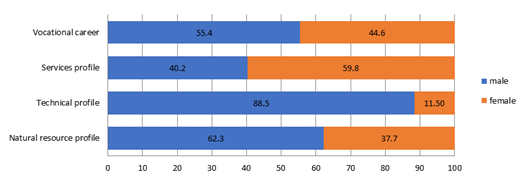
Regarding the chosen specializations, there are some where the distribution on both genres is relatively balanced (figure
Student
Differences are statistically significant in terms of Hungarian students, which are in
Most of the students included in the sample belong to the
Therefore, in terms of individual characteristics, research data shows that boys show greater attraction for vocational and technical education than girls, the data reproducing the perception in the collective mind about the higher compatibility of boys with activities requiring technical training.
Features of the originating family environment
In order to investigate the relationship between the socio-economic environment of origin and the profiles found in the vocational and technological education, we followed the main indicators regarding the structure of the students' family. Most students in our study come from rural areas. 62.3% of their parents are stable in communes, 28.3% are from Oradea, and 9.5% live in small towns in Bihor County (figure
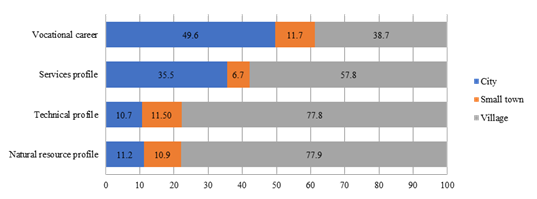
Regarding the distribution of students from rural and urban areas, the differences found on the profiles of vocational and technological education are significant (Chi-square = 241.30, df = 6, p = .000). Of all the students enrolled in the vocational career, 50% have parents with stable residence in Oradea, significantly higher than the 39% of students whose parents are from rural areas. The services profile is 60% of students with rural parents, and only 7% are from small towns. At the technical profiles - 77.8% and natural resources - 77.9%, most of the students come from rural emigration. Students in vocational and technological education come from rather large families. The average number of household members is 4.47, with a standard deviation of 1.91 (vocational profile - 3.9, service profile - 4.7, technical profile - 4.6, natural resource profile - 4.6).
Data on the structure of the students' family reveals significant differences. The average number of people living in the household is lower for students enrolled in the vocational career. In contrast, in the profile of services, the average number of family members is higher by 4.7 people.
Analyses of the number of siblings indicate different results. We obtain an average number of older brothers / sisters in the case of students enrolled in the natural resources profile (2.3), and the average number is smaller (1.4 brothers / sisters). On the profile we have 1.5 and technical profile - 1.6.
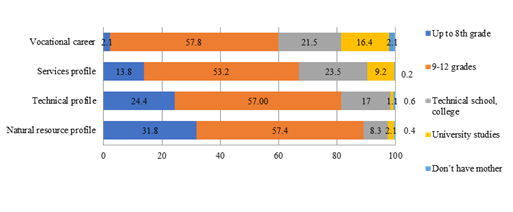
The results are also consistent with the father's level of instruction. And for this indicator, students with a lower level of education are found in the case of natural and technical resources. At the vocational level, 15% of students have university studies, and in the profile of services, 34% of students have a father who graduated from a post-secondary technical school (figure
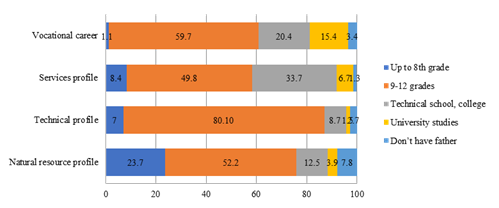
In consistent with the above, and considering the relationship between parenting and the area where they carry out their professional activity, analyses indicate significant results in terms of parental occupation. For the significance tests performed for these indicators, we obtained the following values: Chi-square = 411.02, df = 15, p = .000 for the occupation of the mother, Chi-square = 650.81, df = 18, p =. the field in which the father operates. Thus, we can see that the students' parents work in the same field (30% of the mother’s works in the vocational field, respectively 43% of the fathers are in this situation).In contrast to the natural resource profile, 34% of the students have a domestic mother, and the profile of services is 41%. Therefore, in the case of the vocational field,
And in the analysis of the father's field of work, there is an overlap in the training chosen by the students and the father's profession in the technical profile. 64% of students in this profile have fathers who have a technical profession. With regard to the students in the service profile, most of them have professional fathers in the technical field (46%), respectively in services (30%). For this indicator, we can also point out that inactive students (who are not currently on the labour market) are present at the highest percentage for students enrolled in the natural resource profile (15% of the fathers of these students are retired).
In order to assess the economic situation of the family from which the students enrolled in vocational and technological education, we used an indicator on the assessment of household incomes. Results show differently significant values (Chi-square = 513.44, df = 15, p = .000). According to the data below, in the vocational field, students appreciate that household incomes are sufficient to ensure a decent living. 62% of the students in this profile claim that household income is enough for them or a decent living without having the opportunity to buy more expensive items. Instead, students from technical profiles and natural resources appreciate that the family has better income, and the family is able to acquire more expensive products. The values obtained are interesting, taking into account the results obtained previously. If we assess the level of parenting the number of household members, students from the natural resource profile, come from more numerous families with less well-trained and inactive parents (figure
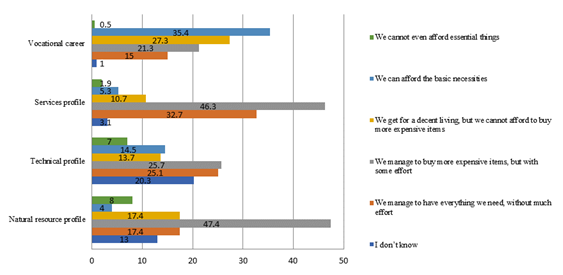
Another indicator used to assess the economic situation of the students’ families is the number of rooms in the dwelling. On average, student dwellings have 3.69 rooms. The average number of rooms is higher for students from the natural resource profile (figure
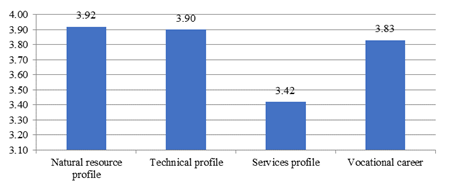
Conclusion
Democratic societies are generally considered to be meritocratic societies where the choice of the educational route is based on merit, talent or intelligence, usually quantified by the grades students obtain, especially in the selection times to higher cycles. However, career guidance is directly or indirectly influenced by other factors that may obstruct the natural evolution of the careers of individuals. Regardless of talent or intelligence, factors such as social background, characterized by family, residence, entourage, media, school environment, etc. may influence directly or indirectly the career choice.
The research carried out in the vocational and technological high schools in Bihor County reveals significant differences in the profiles of the students enrolled in the categories available in this type of education: technical profiles, services, natural resources and the vocational field. Moreover, these results are under the impact of the individual characteristics of the students (gender, ethnicity) and the characteristics of their families of origin (residence environment, parental education level, number of household members).The hypothesis formulated in relation to the relationship between gender and student orientation towards profile types has been confirmed to the greatest extent in the two profiles (technical and natural resources), giving rise also to an explanation from the perspective of human capital theories, according to which the girls are disposed more to memory, have better school results, which gives them access to more selective profiles, pedagogical, services, vocational and natural resources, and boys mostly to the technical and theological profile.
We also get gender differences in these two profiles. There are significantly more boys in the technical profile (88.5%), except in the textile and leather industry where there are more girls. On the profile of natural resources, more boys are in forestry specialization (98%) and several girls in the food industry (53%). Regarding the ethnicity, several Hungarian students are enrolled in natural resources. Roman Catholic students account for 66% of the technical profile and 34% of neo-Protestant students, significantly higher than 7% of students in this religion who are on the profile of natural resources. Most students from these two profiles come from rural areas (almost 80% of them). Their families are numerous, with an average of 4.6 people and between 1.6 and 2.3 brothers. Parenting levels are lower. 32% of mothers of students from the natural resources profile have up to 8 classes and 24% of mothers in the technical profile are in this situation. The data show similar values for father's education. They are parents in the case of these students who are inactive, to the profile of natural resources, 34% of the students have a domestic mother and 15% of the fathers of these students are retired.
Consequently, the hypothesis regarding the
It also highlights the strong
References
- Becker, G. (1997). Capitalul uman. O analiză teoretică şi empirică cu referire specială la educaţie. [Human Capital. A theoretical and empirical analysis with special reference to education]. Bucureşti: All.
- Boudon, R. (1997). Efecte perverse şi ordine socială. [Perverse effects and social order]. Bucureşti: Eurosong & Book.
- Bourdieu, P., Passeron, J.C. (1977). Învăţământ şi reproducţie socială in Sociologia educaţiei şi învăţământului, [Education and Social Reproduction in Sociology of Education]. Bucureşti: Didactică şi Pedagogică.
- Ciobanu, NR. (2018). Pleading for reading in the 21st century in International Journal of Innovation and Research in Educational Sciences, 5(1), 57- 62.
- Ciucă, V. (coord.). (2006). Vocational Training System for People with Intelectual Disabilities. [Sistemul de formare profesională pentru persoanele cu dizabilități intelectuale]. Programul LEONARDO DA VINCI (RO/03/B/F/PP175022), Bucureşti: Agora.
- Florescu, M.C., Barth, K. (2017). Field training practice of students in Romanian vocational education in Journal Kora Gyermekkori Neveles, II, 26-42. Debrecen: University Press Debrecen.
- Florescu, M.C. (2016). Evoluţia învăţământului vocaţional românesc şi implicarea sa asupra pieţei forţei de muncă, [Evolution of Romanian vocational education and its implication on the labor force market]. Bucureşti: Didactică şi Pedagogică.
- Hatos, A. (2006). Sociologia educaţiei. [Sociology of education]. Ed. a II – a, Iaşi: Polirom.
- Narly, C. (1938). Pedagogia generală. [General pedagogy]. Bucureşti: Cultura Românească.
- Vlădulescu, L. (coord.). (1997). Ghid metodic pentru proiectarea şi desfăşurarea activităţii de calificare în învăţământ tehnic. [Methodological Guide for the design and performance of technical education qualification]. Bucureşti: Editura Gelsor SA.
Copyright information

This work is licensed under a Creative Commons Attribution-NonCommercial-NoDerivatives 4.0 International License.
About this article
Publication Date
15 August 2019
Article Doi
eBook ISBN
978-1-80296-066-2
Publisher
Future Academy
Volume
67
Print ISBN (optional)
-
Edition Number
1st Edition
Pages
1-2235
Subjects
Educational strategies,teacher education, educational policy, organization of education, management of education, teacher training
Cite this article as:
Florescu*, M. -. C. (2019). Profiles Of Students Enrolled In Vocational And Technological Educational Systems. In E. Soare, & C. Langa (Eds.), Education Facing Contemporary World Issues, vol 67. European Proceedings of Social and Behavioural Sciences (pp. 779-788). Future Academy. https://doi.org/10.15405/epsbs.2019.08.03.93
